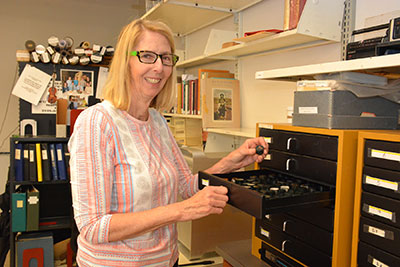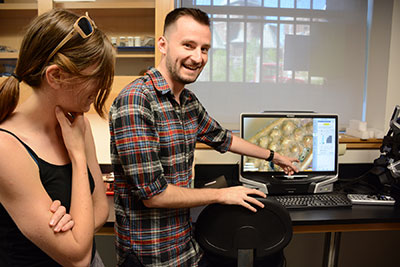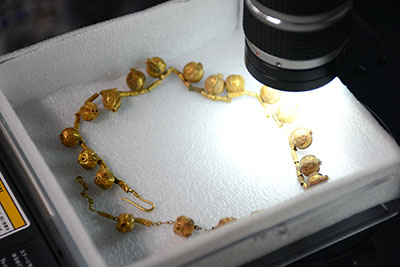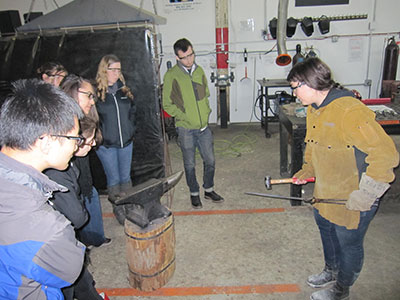Archaeometallurgy is the scientific investigation of the technology and provenance of ancient metals. The study of the production, processing, and exchange of metal in prehistoric and historic times has a long tradition at the Penn Museum. The Center for the Analysis of Archaeological Materials (CAAM) now integrates archaeometallurgy into Penn students’ education.


Many leading archaeometallurgists have worked at the Museum in recent decades, originally through the Museum Applied Science Center for Archaeology (MASCA): Tamara Stech, Stuart Fleming, Elizabeth Hamilton, Robert Maddin, James Muhly, Sam Nash, and Vince Pigott to name but a few. The collection of analyzed artifacts they assembled now contains more than 1,600 mounted specimens of ancient metal and metallurgy-related artifacts. In recent years, archaeometallurgist Sam Nash and volunteer Cynthia Orr created a digital database with detailed information on the artifacts’ origins and the results of MASCA analyses. The artifact collection has seen renewed use over the past year through CAAM, and students have had the opportunity to carry out unique archaeometallurgical projects.
In Spring 2016, six Penn graduate students attended the Archaeometallurgy Seminar. In a lab-based setting, they learned how to trace metal through its production sequence from the exploitation of ore to smelting, processing, shaping, and trading of metal artifacts. CAAM’s and Conservation’s laboratories are equipped with mounting, grinding, polishing, and etching tools, various microscopes, a portable x-ray fluorescence analyzer, and a modern radiography unit. Students were able to use much of this equipment for their class projects to reconstruct manufacturing processes of ancient artifacts. “The practical part of the class was fun and rewarding. My samples were from objects that were not very interesting to look at on the macroscopic level, so I was excited to see how they looked under the microscope. It was also cool to see things we had read about or learned about in lecture in real life in our samples,” said Janelle Sadarananda, Graduate Student, Art and Archaeology of the Mediterranean World.


A highlight of the course was a visit to the Philadelphia Sculpture Gym, where the processing techniques of metal casting and blacksmithing were demonstrated for the students. In addition, students visited other University of Pennsylvania facilities that provide a more detailed study of ancient metals. The scanning electron microscopes at the Laboratory for Research on the Structure of Matter and the atomic absorption spectroscopy of the Department for Earth and Environmental Science are both useful supplements for archaeometallurgical research in CAAM.
Individually designed projects provided the students of the Archaeometallurgy Seminar with an opportunity to engage in scientific research. “As part of the research into Hasanlu mace heads, we went into storage to examine objects listed on the Museum collections database, as well as similar items that were not described as mace heads. The opportunity to make our own examination led to the identification of two other objects that fit into the same typological category as the already examined nine mace heads. Access to Museum collections is a very important benefit of research in the Museum,” stated Marshall Schurtz, Graduate Student, Near Eastern Languages and Civilizations.
Our students were trained in using different methods of Archaeometallurgy to answer their research questions. The topics of their projects ranged from Bronze Age Cyprus to Iranian mace heads to East Asian bronzes. What are the main components of the ancient alloys? How were the artifacts formed? “My project mainly uses pXRF on the metal objects of the Mayer collection in the Penn Museum. We ran tests on more than 400 pieces of objects. The results from the pXRF are incredibly useful and detailed. With these results, we now know the basic compositional information of these objects, and have also found gilded and tinned objects among them. We are even ready to discuss the dating problem and forgery issue in the Mayer collection,” said Fangyi Cheng, Graduate Student, East Asian Languages and Civilizations. The results of these research projects will also contribute to the Museum’s collections database, since the descriptions of the metal artifacts will be reviewed by the students. We look forward to our future students’ research!
Moritz Jansen is a Teaching Specialist, CAAM.
